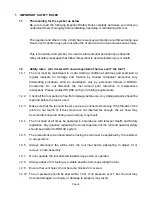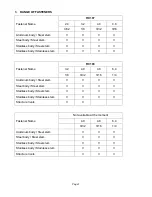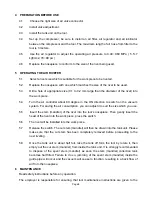
Page 8
4
PREPARATION BEFORE USE
4.1
Choose the right size of air valve connector.
4.2
Install valve adjustment.
4.3
Install the tank unit on the tool.
4.4
Set up the compressor, be sure to install an air filter, air regulator and air lubricator
between the compressor and the tool. The maximum length of air hose from filter to the
tool is 3 meters.
4.5
Use the air regulator to adjust the operating air pressure to 0.49~0.69 MPa ( 5.5~7
kgf/cm2, 78~99 psi )
4.6
Replace the nosepiece to conform to the size of the rivet being used.
5
OPERATING THE AIR RIVETER
5.1
Select a rivet size which is suitable for the work piece to be riveted.
5.2
Replace the nosepiece with one which matches the size of the rivet to be used.
5.3
Drill a hole of appropriate size (0.1 to 0.2 mm large than the diameter of the rivet) into
the work piece.
5.4
Turn the air controller about 90 degree in the ON direction to switch on the vacuum
system. For saving the air consumption, you can adjust it to suit the size which you use.
5.5
Insert the stem (mandrel) of the rivet into the tool’s nosepiece. Then gently insert the
head of the rivet into the work piece, press the switch.
5.6
The rivet will be installed into the work piece.
5.7
Release the switch. The cut stem (mandrel) will then be drawn into the tank unit. Please
make sure that the cut stem has been completely removed before proceeding to the
next riveting.
5.8
Once the tank unit is about half full, take the tank off form the tool by rotate it, then
empty out the cut stem (mandrel) from inside the tank unit. It is strongly recommended
to dispose of the spent stem (mandrel) as soon the stem (mandrel) collection tank
becomes half filled. Failure to do so, jamming of the spent stem (mandrel) inside the
guide pipe will occur and the vacuum will cease to function, resulting in a back flow of
air from the nosepiece.
6 MAINTENANCE
Read safety instructions before any operation.
The employer is responsible for ensuring that tool maintenance instructions are given to the













